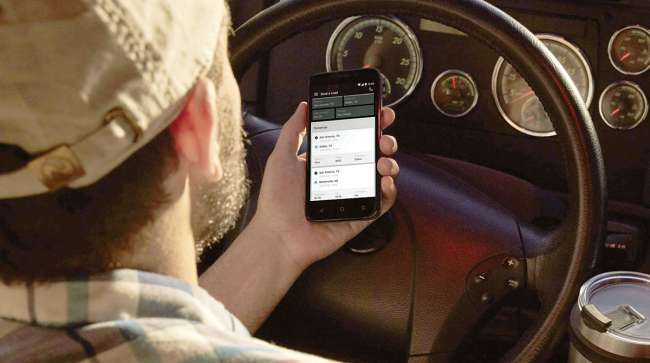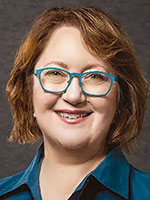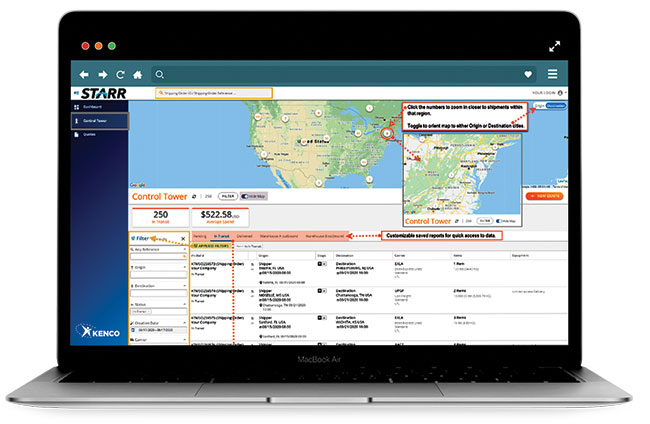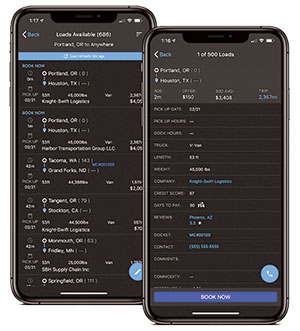Staff Reporter
Load Board Operators Streamline Processes Using Automation, Artificial Intelligence

[Stay on top of transportation news: Get TTNews in your inbox.]
Advances in technology are transforming traditional freight matching processes.
Load board operators, logistics companies and technology vendors are increasingly utilizing improved data analytics, artificial intelligence and business-process automation to more efficiently connect loads with trucks to move them.
Although this innovation is enhancing freight matching capabilities, the core mission still boils down to a simple premise.

Boone
“I think it starts with the customer and really understanding their problems,” said Nadya Duke Boone, vice president of product at DAT Freight & Analytics. “When they’re looking at that load they actually have lots of different things in their heads that they’re trying to juggle. What we’re doing is bringing all that together in one streamlined way. I think that’s where the power of automation can really help if you do it right.”
Boone added that one approach to solving customer problems is to help carriers and shippers filter out information they don’t need while automating manual processes. DAT Book Now was launched last year with that very goal in mind.
Brett Webb, chief product officer at Truckstop.com, noted that figuring out what is working and what isn’t is how the streamlining process starts. Truckstop.com, she said, has worked directly with its customers and invested heavily in its products and technology teams to do just that.
“How do we help them be more effective and efficient and how do we get the work flows correct to provide them answers at the right time so they can make quick decisions?” Webb said.
Logistics services provider Kenco Group also is utilizing business-process automation.
“A couple of good examples where we got some traction are things like tracking and tracing,” said Mike McClelland, Kenco’s senior vice president of transportation.
Kenco also uses robotic process automation techniques for back-end processes such as freight payment activity. In addition to that, the company started using it for large online retailers that may want to use their own fleet but integrate other services like warehousing, coordinating and setting appointments.
“It is a marketplace so you have to make sure demand and supply meet,” said Natarajan Subbiah, head of product at Uber Freight. “Every time I’ve talked to someone in the logistics space and the shippers of the world, no one ever has said they have a lot of free time. So this means that we have to make things super easy for them to basically improve their daily quality of life.”
The modern freight-matching process is fundamentally based on technology, so technological advancements play a crucial role in it becoming more streamlined and effective. Those advancements can take many forms such as automation, machine learning and AI.
“We are investing heavily in robotic process automation to eliminate any type of manual work, any type of data entry that we’re having to redo in various systems,” said Kristi Montgomery, vice president of innovation at Kenco.
Kenco has a proprietary machine-learning AI tool, dubbed DaVinci AI, that’s used for predictive analytics on service failures and estimated time of arrival.
The firm has recently implemented a few other technology solutions to reduce manual tasks and paperwork. Kenco STARR was launched Feb. 23 to provide small to midsized shippers with a TMS. Kenco also recently launched control tower capability for its transportation group. HubTran is being used to automate back-end processing.

With its Kenco STARR app, Kenco has made an investment in robotic process automation to eliminate the manual work of data entry that has succumbed to occasional human error. (Kenco)
Last year, Uber Freight pushed out several solutions to market to help supply chain participants navigate the COVID-19 pandemic.
“It helped us weather through the market fluctuations, which we had quite a few last year,” said Subbiah, adding Uber Freight’s carrier network of nearly 65,000 drivers helped the company grow 43% in the fourth quarter of 2020 compared to 2018.
He also noted their pricing models use machine learning to analyze data points across their entire network to come up with accurate pricing for loads almost instantaneously. Uber Freight Link and Market Access were also launched to allow large customers to access its network.
“For those smaller shippers, we basically built a fully self-serve platform called the Shipper Platform that allows them to price and tender loads almost instantaneously,” Subbiah said. “Because we price loads instantaneously, we make it super easy for shippers.”
Enhancing Data Analytics
Truckstop.com’s Webb highlighted automation and machine learning when it comes to important streamlining technologies.
The load board operator is in the process of migrating its customers to a new load search with more precise rate estimates with the goal of making its freight matching products easier to use.
Webb and her product management team created a “summary card” that serves as the decision tree for how carriers make a decision, whether it’s to book a load or call a broker in order to book a load.

When the pandemic started, drivers faced crowded parking lots, closed rest areas and minimal roadside support. And almost a year and a half later they still face the fear of not finding a place to park, which means having no place to rest. In this episode, host Michael Freeze seeks answers from those on the forefront of research and legislative action. Hear a snippet above, and get the full program by going to RoadSigns.TTNews.com.
“That is kind of the simplest part of that automation that we’ve been investing in, just keeping that user interface simple, streamlined and with the right data at the right time,” she explained.
DAT Book Now was launched as an automated booking option for select loads in April 2020. It was designed to streamline the tendering process so that carriers can search for loads and lock in a rate with the click of a button on their mobile or desktop device.
“It really makes a big difference in our carriers’ lives because this last year the market has been very hot, carriers are in a high demand and they get a lot of phone calls,” Boone said. “So when you start to bring something like Book Now into the equation, now, suddenly on either side of that, both sides are feeling a lot more efficient. It’s like we’re reducing the noise for them, or just filtering out the stuff that they don’t want to hear.”
Load board operators are also very much focused on data processing to improve and streamline their services. The more information they have on freight being moved and who is moving it, the more accurate their systems can be. But in addition to that, the more real-time data being fed into their machine learning and AI processes, the more they can naturally improve.
Webb cited rate estimate solutions as an example of using data to create innovative solutions to help customers. Traditionally, rates are usually determined based on 14- or 7-day lane averages, she said. Truckstop.com has been working to improve that.
Through its investments in data science, Truckstop.com realized the need to get “hyper granular,” Webb explained, by looking at specific load attributes, supply and demand in the marketplace, as well as data from its entire product line, from payments to freight matching to rate-per-mile.
“And what we’ve come up with is a way to say, to our carriers in this case, here is the current rate for this load. Here is the market rate for today,” she said.
Putting It All Together
Digital platforms need three things to be successful, said Trucker Tools CEO Prasad Gollapalli.

Gollapalli
“One is they have to have live, real-time data on where the trucks are available,” he said. “Usually, that’s done through a mobile app, so they have to be connected to a mobile app. The second one is they have to have a huge group of small carriers and owner-operators. The third thing is tools such as artificial intelligence and machine learning to clearly identify and put the right load in front of the right truck.”
Matching the right load with the right truck means not just understanding where the truck will be available in real time, but also determining what lane and what destination is most beneficial to the driver, Gollapalli added.
“The fastest and simplest way to look at the efficiency is how could a brokerage become faster without adding operational expenses,” Gollapalli said. “For example, how can they move 4,000 loads in a month without having to increase their head costs. That’s where efficiency comes in with a digital platform.”
The ability to collect as much data as possible is critical for the advancement of load boards and freight matching. But it does create a unique problem. There also has to be a balance between that immense data collection and knowing which specific data points to present to shippers and carriers so they have all the information they need without being overwhelmed.
“With our Book It Now solution, we’ve invested in a predictive matching platform,” Webb said. “If a broker has their core carriers on their carrier lists within Truckstop, we can recommend that right next load to our carriers. And we do that right now through the form of an email. We look at where the carrier is or the lanes the carriers have searched for historically. We also look to make sure that we’re not going to send a carrier into an area that doesn’t have any outbound loads for their next pickup and delivery.”
Today, we announced our latest Book It Now #integration with Mercer Transportation, giving #freightbrokers and 3PLs of any size the ability to add instant load booking functionality to their business, https://t.co/9SjnwWzawD #truckingindustry — Truckstop.com (@trckstopdotcom) May 11, 2021
Load board operators aren’t just focused on freight matching. To make the process streamlined and useful to customers they have also offered additional services through partnerships and proprietary solutions, often integrated together to provide carriers, shippers and drivers what they need throughout the entire matching and delivery process.
“Our research has shown that carriers are juggling between 15 and 20 apps,” DAT’s Boone said. “That’s because there’s more to a load than just finding a load.”
Truckstop.com has a payments platform that helps carriers get paid as well as a TMS. Webb noted it goes back to customer workflow and making things as easy as possible for them to use. She added the job in the future is to continue to integrate those offerings into the platforms to make them easier to use.

DAT Freight & Analytics' DAT Book Now helps carriers and shippers filter out information they don’t need and automate processes. (DAT Freight & Analytics)
Trucker Tools’ Gollapalli noted these integrated solutions also have the added benefit of keeping users engaged with the app. That continuous connection means more real-time data can be collected, which in turn helps to improve business planning for carriers.
“He needs to figure out a place to get fuel. Maybe he needs to wash the truck before he actually picks up that load. Once he picks up that load, he needs to track that load to the destination for the shipper and scan documents,” Gollapalli said. “Maybe he needs to bring the load to a weigh scale. He needs to park during the night for an overnight journey. He needs a place where he can eat, take a shower and all that.”
The modern version of freight matching is benefiting from the widespread adoption of cellular technologies. Not only has it provided a platform on which to build new technologies, it also allowed for a greater collection of real-time data that helps fuel machine learning and AI.
“It is truly the smartphone app that changed the space, that really revolutionized us from traditional load matching and load board to digital platforms,” Gollapalli said. “That smartphone app is what is truly driving the digitalization.”
Gollapalli added the technology gives a real connection into a truck. He noted the more the machine learning can learn about a fleet or carrier, the better it can do predictability. He noted every time the system engages with a trucker it’s developing a profile detailing things like where historically that driver likes to go and what types of loads the driver prefers.
“I’ve been with Truckstop for five years now, and it has been very interesting in a way to see how the carriers have adopted the cellphone technology,” Webb said. “I think in the last two years, things have really taken off and drivers and carriers are more and more using cellphone technology.”
Want more news? Listen to today's daily briefing below or go here for more info:


